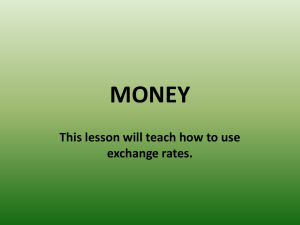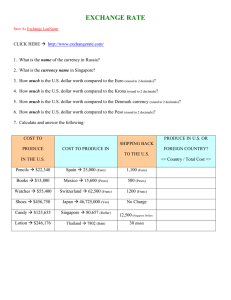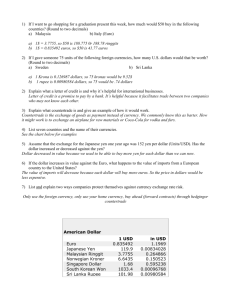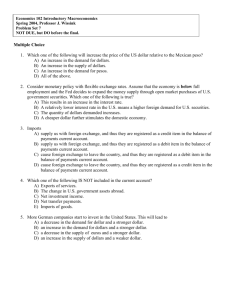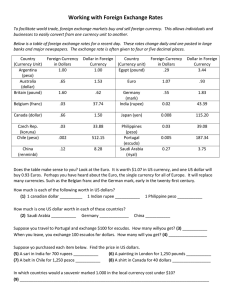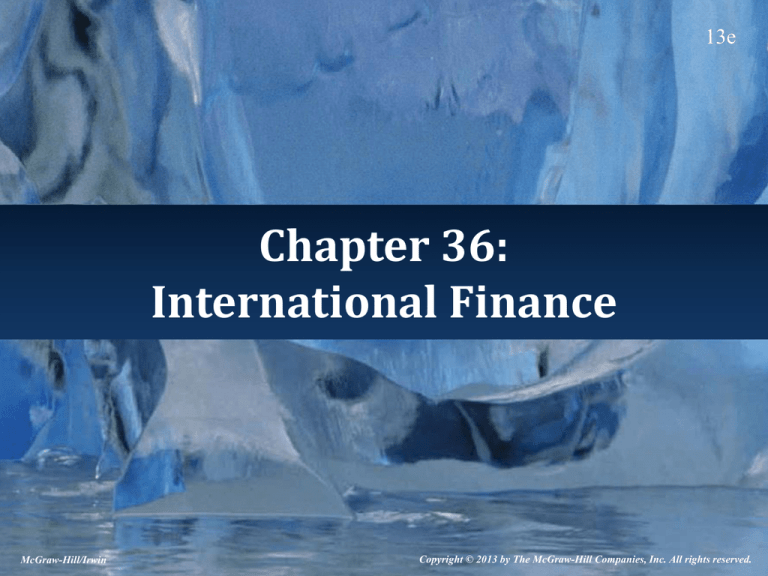
13e
Chapter 36:
International Finance
McGraw-Hill/Irwin
Copyright © 2013 by The McGraw-Hill Companies, Inc. All rights reserved.
International Finance
• Each country has its own currency (except
in Europe, where many countries have
adopted the euro).
• International trade therefore involves two
currencies – that of the exporter (which
needs to pay bills in its currency) and that of
the buyer (which pays for items using its
currency).
36-2
International Finance
• The relative values of the two currencies
will affect trade patterns and ultimately the
answers to the questions of WHAT, HOW,
and FOR WHOM to produce.
36-3
Learning Objectives
• 36-01. Know the sources of foreign
exchange demand and supply.
• 36-02. Know how exchange rates are
established.
• 36-03. Know how changes in exchange rates
affect prices, output, and trade flows.
36-4
Exchange Rates
• Exchange rate: the price of one country's
currency in terms of another’s; the domestic
price of a foreign currency.
• If US$1.50 = 1 euro, then US$1 = 0.67 euro.
• Exchange rates in terms of each other must
be reciprocals of each other.
36-5
Foreign Exchange Markets
• U.S. travelers to Europe have a demand for
euros and a supply of dollars. European visitors
to Disney World have a demand for dollars and
a supply of euros.
• U.S. exporters of goods to Europe get paid in
euros. They have a supply of euros and a
demand for dollars, which they need to pay
their bills.
• European exporters of goods to the U.S. get
paid in dollars. They have a supply of dollars
and a demand for euros.
36-6
Foreign Exchange Markets
• The market demand for U.S. dollars originates
in
–
–
–
–
–
Foreign demand for American exports.
Foreign tourists in America.
Foreign demand for American investments.
Currency speculators.
Possible government intervention.
• The market demand for U.S. dollars represents
a market supply of foreign currency.
36-7
Foreign Exchange Markets
• The market supply of U.S. dollars originates
in
– American demand for imports.
– American tourists abroad.
– American investments abroad.
– Currency speculators.
– Possible government intervention.
• The market supply of U.S. dollars represents
a market demand for foreign currency.
36-8
The Value of the Dollar
• The value of the dollar is indicated by its
purchasing power.
• A BMW costing 30,000 euros must be priced in
dollars if it is to be sold in the United States.
– If 1 euro = $1.50, then it will be priced at $45,000.
– If the exchange rate changed to 1 euro = $1.60, then
the BMW’s price in the United States would rise to
$48,000.
– At this higher price, the quantity of BMWs sold will
decrease.
36-9
The Value of the Dollar
• At a high euro price
of the dollar, fewer
will want to buy
dollars and more
will want to sell
dollars. There will
be a surplus of
dollars, and the
dollar’s euro price
will fall.
36-10
The Value of the Dollar
• At a low euro price of
the dollar, more will
want to buy dollars
and fewer will want
to sell dollars. There
will be a shortage of
dollars, and the
dollar’s euro price
will rise.
• The foreign exchange
market will adjust to
its equilibrium price.
36-11
The Value of the Dollar
• Any increase in demand for the dollar or
decrease in supply of the dollar will push
the dollar price in euros up. The dollar
appreciates in value.
• Any decrease in demand for the dollar or
increase in supply of the dollar will push the
dollar price in euros down. The dollar
depreciates in value.
36-12
The Value of the Dollar
• When the dollar appreciates against the
euro, the euro depreciates in value relative
to the dollar.
• When the dollar depreciates against the
euro, the euro appreciates in value relative
to the dollar.
36-13
The Balance of Payments
• The summary of all international money flows
is contained in the balance of payments.
– Balance of payments: a summary record of a
country’s international economic transactions in a
given period of time.
• The balance of payments is divided into three
parts:
– Current account balance (which includes the trade
balance).
– Capital account balance.
– Statistical discrepancy.
36-14
The Balance of Payments
• The current account balance includes
– The trade balance:
• Merchandise exports and imports.
• Service exports and imports.
– Other money flows:
•
•
•
•
Income inflows from U.S. investments abroad.
Income outflows for foreign-owned U.S. investments.
Net U.S. government grants to foreigners.
Net private transfers and pensions.
• There is a net dollar outflow in the current
account.
36-15
The Balance of Payments
• The capital account balance includes
– Inflow due to foreign purchases of U.S. assets.
– Outflow due to U.S. purchases of foreign assets.
– Increase in U.S. official reserves.
– Increase in foreign official assets in U.S.
• There is a net dollar inflow in the capital
account.
36-16
The Balance of Payments
• If we had perfect accounting, the outflow in the
current account would be balanced by the
inflow in the capital account.
• Because the accounting process has several
time lags in collecting data, the third part of the
balance of payments is the statistical
discrepancy, which indeed balances the two
accounts.
• Therefore, the balance of payments always
must equal zero.
36-17
Market Dynamics
• Review:
– Depreciation: a fall in the price of one currency
relative to another.
• Caused by a decrease in demand or an increase in
supply of the first currency.
– Appreciation: a rise in the price of one currency
relative to another.
• Caused by an increase in demand or a decrease in
supply of the first currency.
36-18
Market Dynamics
• What market forces could cause an increase in
demand for the dollar?
–
–
–
–
Foreign incomes rise faster than U.S. incomes.
Foreign prices rise faster than U.S. prices.
Foreigners have an increased need for U.S. goods.
U.S. interest rates become higher than in foreign
countries.
• Vice versa, and there would be a decrease in demand
for the dollar.
• Small changes like these occur all the time, and the
$4 trillion foreign exchange market adjusts to those
changes.
36-19
Do Exchange Rates Matter?
• Daily participants in international trade
prefer stable exchange rates to reduce the
uncertainty in planning.
• Any exchange rate change automatically
alters the prices of exports and imports of
that country, affecting many business
decisions.
36-20
Do Exchange Rates Matter?
• Trade deficits, caused by U.S. demand
increase for foreign goods, essentially
reduced American jobs as more products
were made abroad.
• The returning capital inflow had foreigners
buying U.S. assets, including government
bonds. U.S. foreign debt and interest costs
increased.
36-21
Should the Government Control
Exchange Rates?
• An intervention would be intended to
achieve exchange rate stability.
• However, stable exchange rates can lead to
other economic effects.
• The standard way to eliminate instability in
exchange rates is to adopt fixed exchange
rates.
– All major trading countries agree to keep the
exchange rates between each currency fixed.
36-22
Should the Government Control
Exchange Rates?
• The easiest way to fix exchange rates is to
define each currency’s value against a common
standard, such as a gold standard.
– Gold standard: an agreement by countries to fix the
price of their currencies in terms of gold.
• The problem with fixed exchange rates is that
the demand for and the supply of each
currency will continue to fluctuate, and a fixed
exchange rate does not account for this.
36-23
Fixed Exchange Rates
• With fixed exchange
rates (at e2), the
increase in demand
for pounds generates
a shortage of pounds.
• More dollars flow out
than flow in, so it
creates a balance of
payments (BOP)
deficit for the United
States and a BOP
surplus for Britain.
36-24
Fixed Exchange Rates
• What to do?
• Let the exchange rate
rise (not acceptable),
or the U.S. government
intervenes by selling
pounds it owns and
buying dollars.
• Also, the U.S. could
transfer gold to Britain
for dollars.
• This can be done once
or twice, but cannot be
kept up forever.
36-25
Fixed Exchange Rates
• Alternatively, the United States could erect
protective barriers to eliminate the increased
demand for British goods.
• Or the United States could increase taxes to
reduce disposable income and thereby the
demand for imports.
• Or interest rates could be raised to slow
spending and to draw foreign currency to the
United States.
• To do this, the policy focus would have to shift
away from full employment or price stability.
36-26


